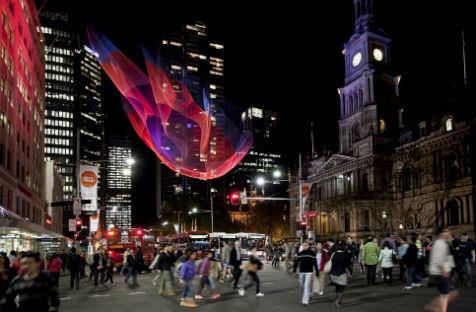As the City of Sydney, City Art program seeks expressions of interest for public artworks, the question is not just what the art will be, but where it will be.
In many public areas it is common for shops, signs, walkways, seating and more to compete for space. When envisioning an artwork for public display it is vital that the work adds quality, not congestion, to the site. This may mean rethinking the area from the ground up in an attempt to visualise a space not as it is, but how it could be.
The three places the City of Sydney, City Art program has selected for public art have very different spatial elements. There is the busy area of George Street, filled with signage and commercial trade. There are the long east-west connecting streets, a two kilometre section of blocks between Central and Circular Quay. There is also a parkland in the Green Square urban development area.
The City Centre Public Art Plan and the Green Square Public Art Strategy are filled with ideas for the placement of artworks that will cause pedestrians to rethink their idea of each space.
The Green Square Public Art Strategy highlights the idea of discrete works that can blend in with the environment and even be incorporated into seating and landscaping for the Drying Green.
For the east-west connecting streets examples have been shared in the City Centre Public Art Plan that include art on the ground plane in the form of paving treatments or micro-works with repeated elements.
To combat competition for space along George Street, one possible approach is to have art up high, above the mid-level line of retail signage or even higher. There are also ideas to fill disused or forgotten spaces with art.
According to City Centre Curatorial Advisor Barbara Flynn, ‘… One of the important goals is to unify George Street – from the City perspective we were thinking if an artist would, for example, work with the void spaces, that might be one way of establishing unity all along the length of the street. But there could be other ways that artists may come up with, to create unity and endow George Street with greater legibility.’
The examples in the two public art plans are there to help artists visualise and invent ways a space can be opened up with public art. It is up to the artists who put in expressions of interest to consider the artist briefs supporting the two public art plans (which go live today), to create inspired concept designs for site-specific works of public art.
Lord Mayor Clover Moore is hopeful that the works selected will be able to engage the public in surprising ways.
‘We want people to be inspired and intrigued as they walk around the city. Whether it’s Caroline Rothwell’s hooded little girl on George Street (Youngsters) or Michael Thomas Hill’s remarkable mesh of bird cages above Angel Place (Forgotten Songs), public artworks tempt you to take a second look as you walk the streets.’
The challenge has been set.
For more information read the City Centre Public Art Plan, the Green Square Public Art Strategy, or visit the City Art site.
(Pictured: Janet Echelman’s ‘Tsunami 1.26’ over George Street)





